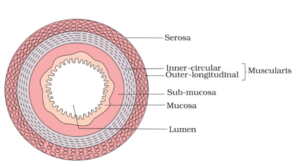Digestion and Absorption MCQ/Objective questions Chapter 16 Biology
Why our body breaks complex macromolecules into simple molecules?
- a. Complex molecules are harmful to our body
- b. Our body can not utilize complex molecules as such
- c. Complex molecules take low space in storage
- d. None
Teeth of most mammals including humans are fit into the socket of the jaw bone. This attachment is:
- a. Thecodont
- b. Monophyodont
- c. Diphyodont
- d. Multiphyodont
Biggest organ in a human is:
- a. Liver
- b. Stomach
- c. Skin
- d. Lung
Human teeth formula is :
- a. 2 X 033/433
- b. 2 X 331/133
- c. 2 X 2133/2133
- d. 2 X 2222/2222
Common place for food and air in the mouth is
- a. Pharynx
- b. Larynx
- c. Glottis
- d. Trachea
Wall layer from alimentary canal to the rectum in outer to inner fashion is:
- a. Serosa<muscularis<Mucosa<sub-mucosa
- b. Seorsa<muscularis<sub-mucosa<mucosa
- c. Seorsa<mucosa<muscularis<sub-mucosa
- d. Seorsa<mucosa<sub-mucosa<muscularis
Lymph vessels that absorb smaller fatty acids from intestine is:
- a. Crypts of Liberkuhn
- b. Microvilli
- c. Lacteals
- d. None
Largest gland of a human body is:
- a. Kidney
- b. Liver
- c. Gall bladder
- d. Salivary gland
Thin connective tissue sheet that cover the lobes of a liver is:
- a. Bowman’s capsule
- b. Glisson’s capsules
- c. Pericardium
- d. None
Sphinctor of oddi guard:
- a. Bile duct
- b. Pancreatic duct
- c. Hepato-pancreatic duct
- d. None
Which of the following is a storage organ for bile juice
- a. Gall bladder
- b. Liver
- c. Pancrease
- d. Intestine
Digestion of carbohydrates starts in
- a. Mouth
- b. Esophagus
- c. Stomach
- d. Ontestine
Small broken masticated food mixed with saliva that enter esophagus is:
- a. Bolus
- b. Chyme
- c. Embolus
- d. None
The food mixed with gastric juice and turned in the stomach is:
- a. Bolus
- b. Chyme
- c. Embolus
- d. None
A protelytic enzyme found in the stomach of infants that help I the digestion of milk is
- a. Pepsin
- b. Renin
- c. Trypsin
- d. None
Pepsin works only in the presence of gastric juice because it needs:
- a. Alkaline medium
- b. Neutral PH
- c. Acidic medium
- d. None
Following is a constituent of pancreatic juice except one which is:
- a. Trypsinogen, Chymotrysinogen
- b. Procarboxypeptidases
- c. Amylase, lipase, nuclease
- d. Pepsin
Which clls in the intestine secrete mucus?
- a. Parietal cells
- b. Goblet cells
- c. Hepatic cells
- d. None
Trysin works in
- a. Alkaline medium
- b. Acidic medium
- c. Neutral PH
- d. None
Major function of large intestine is:
- a. Absorption of food
- b. Absorption of water
- c. Lubrication of undigested material
- d. Both b and c
See also:
Plant Growth and Development MCQ
Photosynthesis in Higher Plants MCQ
Digestion and Absorption MCQ/Objective questions Chapter 16 Biology
Ref: Chapter 16.
